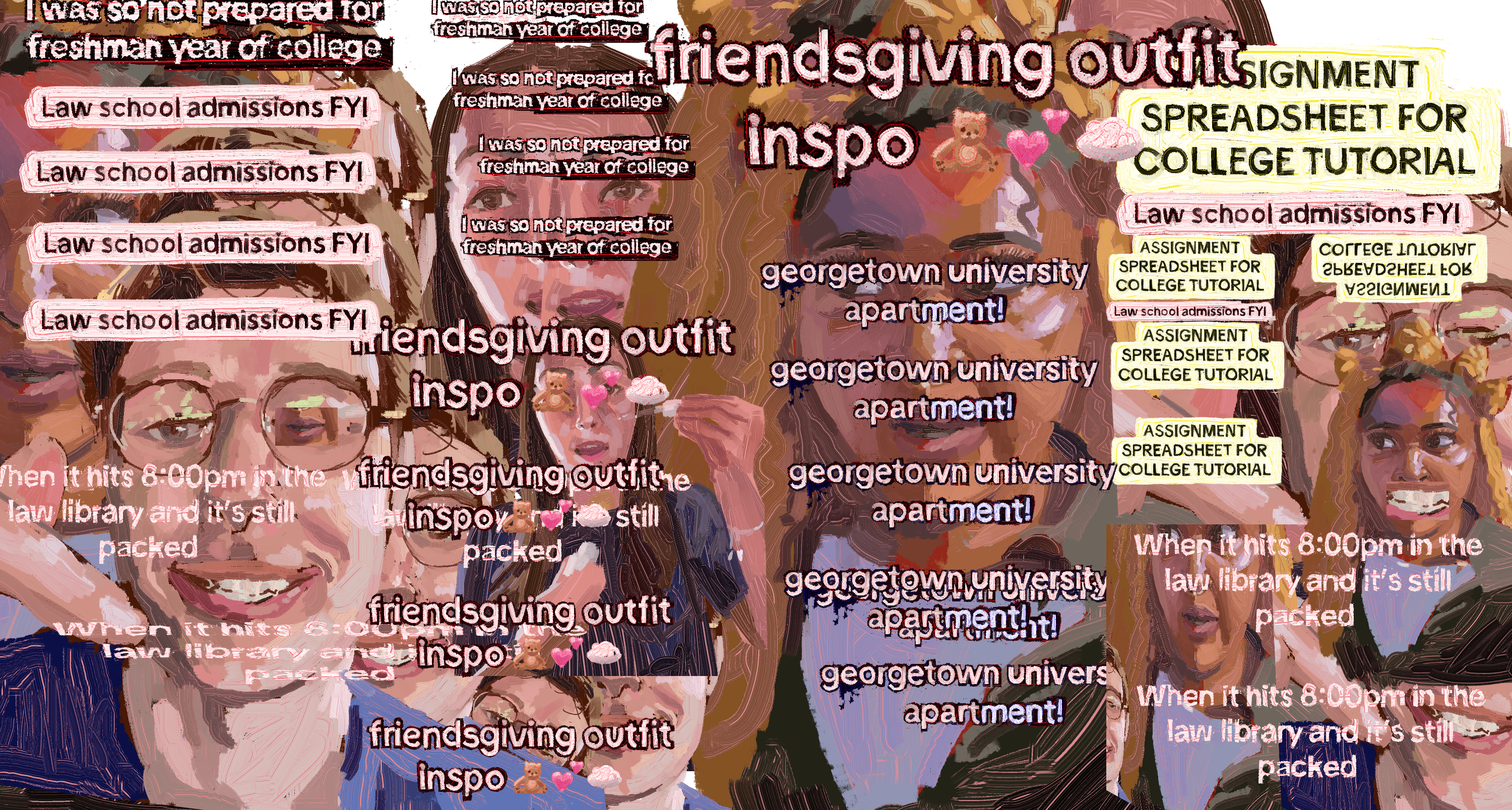Like many young people across the country, Georgetown students may find themselves scrolling for hours on TikTok to escape the reality of an 11:59 p.m. deadline.
Some Georgetown students have capitalized on the popularity of TikTok among their peers to create content. It’s not uncommon for students to find people they know on their “For You” page while “doomscrolling.” Unlike other social media platforms, TikTok’s “For You” page allows smaller influencers to be featured more easily, fostering an environment for rapid growth for micro-influencers—content creators with 10,000 to 100,000 followers—who may be more relatable to their audience than more well-established online celebrities.
Joey Trigiani’s (MSB ‘26) TikTok success began by accident. Now, @joeytrigiani boasts over 33,000 followers and 1.9 million likes.
“I’d make some Amazon storefronts of things that people might need to bring to college with them,” Trigiani said. “I decided to share them with a wider audience. Just gave it a shot and threw one on Tiktok. It kind of blew up overnight, unexpectedly.”
Similarly, Amanda Bloom (SFS ‘27) didn’t expect to gain traction on social media. Her TikTok account, @amandabloomm, has almost 27,000 followers and 1.6 million likes. One of her viral videos, posted in April 2024, shows clips of her Copley dorm and has since amassed 4.4 million views and almost 900,000 likes.
“I was just kind of posting stuff, not really with the purpose of anyone seeing it,” Bloom said, “It was just a creative outlet for me.”
Unlike Trigiani and Bloom, Arianna Mackey’s (LAW ‘26) prior experience with social media helped to propel her into content creation. Her account, @badgaalariri, has over 27,000 followers and 3.4 million likes.
“I’ve always been a creative,” Mackey said, “I ran a social media account for HBCU [Historically Black College or University] paraphernalia and Greek life paraphernalia. And so that’s when I got really into content creation.”
While Mackey, Trigiani, and Bloom center parts of their content around Georgetown, each of them has fostered different communities and niches.
For Bloom, her content has always revolved around her personal life. She regularly posts morning routines, day-in-the-life slides, and get-ready-with-me videos—something, she said, that has allowed her page to naturally evolve into one geared towards prospective students and college-aged women.
Like Bloom, much of Trigiani’s audience consists of high school or college students. Trigiani also said that he has a substantial parental following which he caters some videos to. In a couple videos, Trigiani shares a list of messages that students would want their parents to know, such as how to best support them during the school year.
“I was posting advice to parents sending their children to school, and a lot of them were quite receptive to my messages. They liked how I both incorporated the viewpoint of a teenager, but also the wisdom of an adult, and I thought that that became quite effective,” Trigiani said.
Trigiani and Bloom said that they create content based on what kinds of videos have been received well by their audience, which drives their content into their respective niches. However, when considering how to evolve their content, creators may worry that branching out could risk losing their audience and traction.
Mackey, however, prefers not to stick to a specific category but instead makes content about her various interests including makeup, locs, and fashion.
“Something that I struggle with now is feeling like if I stuck to one niche, maybe it’d be easier to gain a bigger following. But I’m just multifaceted, I guess,” she said.
Striking a balance between creative expression and audience retention is difficult and can feel high-pressure, especially when influencers already experience discrimination on social media for their race and other factors.
Racism is pervasive in the social media industry. A 2021 study found that Black influencers receive 35% less compensation than their white counterparts. Despite several of her videos blowing up on TikTok, Mackey, who is a Black woman, has not received substantial financial compensation for her content on TikTok.
“I probably have garnered $30 via TikTok, and that’s been over two years,” she said.
Racism on social media also manifests in hate comments—something Mackey has experienced.
“I get the most interaction, especially on Instagram, from hateful viewers,” she said. “Obviously, racism is entrenched in every area of our life here in the U.S., and I think that it’s a lot easier for people to stomach law school content from someone that they think should be in law school.”
While hate comments affect Mackey’s mental health, she said that they also empower her to continue content creation.
“It’s always people that are not in law school, and they are deeply offended by the idea that a Black woman is in law school, let alone for free,” Mackey said, “It motivates me because a lot of people—I’ll be out and about—and they’ll come up to me, and not just Black people, anyone that wants to go to law school, and they’ll be like, ‘I’ve seen your content. You really motivated me. You pushed me to want to apply.’”
Through content creation, Mackey aims to find community and be a voice of encouragement and reassurance, especially for her lower-income and non-white viewers.
“The reason that I do all this is because I feel like there’s a lot I just never knew. I just realized there is a knowledge gap,” Mackey said. “One of the most important things to me is making it clear that anyone can go to law school, because we know that there’s a stereotypical law student and a lot of lower-income, first-generation students don’t even know about the possibility.”
According to Mackey, Georgetown’s name and prestige have also helped in establishing her credibility. She said that Georgetown content creators benefit from the prospective students’ interest in content about the school, especially regarding admissions. Like Mackey, Bloom also notes that creating content about Georgetown generates buzz.
“I definitely get a lot of DMs asking for college advice or asking about different aspects of Georgetown,” she said. “Georgetown is just such a good name.”
Mackey said that building a community of followers has also made her impact feel more tangible.
“You see something-k followers, and you don’t recognize that that’s a lot of people. I’m like, ‘Oh, that’s not even that many. Like, people have a 100k,’” Mackey said. “But I’m like, ‘Wait, no. That’s thousands of people.’ So it’s nice to put it in perspective.”
For Trigiani, meeting people who have seen his videos online has helped him grow a deeper appreciation for his content.
“Both my sophomore year and junior year, when the new freshmen would come in, I had multiple of them come up to me and thank me for providing resources that ended up helping them both get into Georgetown and choose to come here,” Trigiani said. “It’s incredible that I’ve been able to have that kind of impact on the people that are younger than me and like I fostered a little sense of community here.”
Besides building a sense of community and purpose on TikTok, many influencers have also benefited financially from the emerging industry. Content creators can earn income through content monetization, gifts, partnerships, and brand deals.
For Trigiani, the ability to earn income from social media has made a significant impact on his academic life.
“Georgetown is extremely expensive, and my family is not one that is just able to pay for it out of pocket completely, as many at Georgetown are. I rely on financial aid to attend Georgetown,” he said. “My social media experience is actually paying my way through school. For some part, it’s largely the reason I’m still able to attend Georgetown.”
However, micro-influencers often do not have the resources, time, or knowledge to acquire help from talent management agencies and must navigate the social media marketing space alone.
“I don’t have management or anything and my account isn’t too big,” Bloom said. “Most of the collaborations I do, they’ll send me something for free, and then I’ll just post a video or take pictures.”
Like Bloom, Trigiani doesn’t have an external social media manager. He manages three revenue streams from social media by himself. He receives some income through the TikTok Creator Fund, which pays him based on the number of qualified views he receives per video. He also earns a percentage commission from his Amazon storefront. However, his largest social media income source comes from brand deals.
“I’ve worked with Aeropostale and lots of brands—that would probably be the largest revenue stream, just because I think the general environment of brands working with influencers is one that is quite costly, and I’ve been lucky enough to reap the benefits of that,” Trigiani said.
While it may be exciting for budding influencers to receive partnerships and free samples, the lack of management makes it difficult to discern how much their content is truly worth, and whether they deserve additional financial compensation for essentially free product advertising.
“I’m not a contract lawyer, my parents aren’t contract lawyers. And suddenly I’m being met with contracts written by the biggest companies in the world,” Trigiani said. “I had no idea what the market rate or the going rate was for someone like me making a 60-second video.”
Like many other influencers, Trigiani’s lack of knowledge caused him much confusion initially. Because of how new and unregulated the social media industry is, it is easy for influencers to lowball their rates, or worse, get exploited for their work by not receiving pay or having their content stolen.
While social media may not become a full-time career for these content creators, it has had a positive impact on their professional lives.
Trigiani is pursuing a more traditional professional path in consulting, but has found his social media career to be a differentiating factor for recruitment.
“I think that having a presence on social media and working with some of these really large brands actually made me stand out in that recruitment process,” Trigiani said. “Being able to speak about one, being creative; two, strategizing; but three, also keeping the bottom line of a large corporation in mind was quite impressive to these consultants.”
Looking to the future, however, Georgetown TikTokers said they are concerned with how a TikTok ban might impact their content creation. The Biden administration signed a bill in April 2024 that would ban TikTok in the U.S. if the company didn’t find a new owner not based in China by January 2025. Trump initially proposed a TikTok ban while in office but now opposes the ban and intends to reverse it. With the uncertainty of TikTok’s future, some influencers have attempted to branch out into other platforms.
“I’m trying to get more into YouTube and just diversify so that it’s not just TikTok, especially if they ban it,” Mackey said, “Instagram, YouTube, Pinterest—especially YouTube because of the monetization. It’s a lot easier to make money off of YouTube than TikTok. And I think long-form videos would be more helpful for law school applicants.”
However, for other influencers, the potential ban has led them to refocus their non financial social media goals.
“I have to keep in mind that it’s not explicitly for the money,” Trigiani said, “Because it all started as a way to make an impact on both the younger generation, but also the older generation. And I have to keep that mission at the forefront.”





